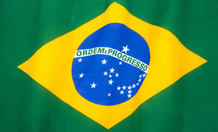
Brazilian flag
Brazil continues to celebrate after Carnival
The popular world view of Brazil may be triggered by thoughts of spectacular Carnivals and skilled footballers, yet the country is also determined to be regarded as a major global power.
The most comprehensive historical review of Brazilian relations with superpower USA has been written by a University of Exeter historian and identifies how the relationship has developed over the last 200 years.
Professor Joseph Smith’s new book ‘Brazil and the United States’ shows the countries have long regarded each other sympathetically, but relations between the two have been adversely affected by geographical distance, language barriers, and cultural difference. With the exception of commerce, notably the coffee trade, there was relatively little contact between the countries during the 19th Century. A convergence of national interests took place during the first decade of the 20th Century when Brazil’s Foreign Minister, Rio Branco, led the way in developing special relations with USA.
The book examines how this relationship was partly based on Brazil’s positioning as a bridge between the Spanish speaking countries in South America and the United States. As the only Portuguese speaking country in South America, Brazil looked to USA for protection and was more favourable to USA than countries like Argentina who later openly sympathised with Germany during the World Wars.
Key aspects of Brazil’s history are shown in the way USA gave 90% military aid to Brazil during World War Two, making it the biggest military powerbase in South America. In addition to North East Brazil becoming a vital supply route to Europe in World War Two, 25,000 Brazilian troops were sent overseas to fight against the Italians. USA rewarded Brazil for this special relationship by assisting the Brazilian steel industry, and bought Brazilian products, such as minerals, uranium and food stuffs in addition to supplying Brazil with weapons.
Professor Smith said, ‘Brazil expected economic gains and diplomatic support for its ambition to be the leading power in South America. Although President Roosevelt said USA would continue to support Brazil, this all changed when USA had to deal with the global threat of communism.’
He added ‘The focus of USA moved from Latin America to the “Cold War” and Russia, so bases in Europe and Japan were more important to them. As a result, Brazil became marginalised and on the periphery.’
According to Professor Smith, Brazil has a history of a boom and bust economy, with the sugar industry and then with diamonds. Today, this may be different as Brazil has a strong industrial base. It is also technologically advanced through its production of aircraft and sophisticated manufactured products. Brazil has recently found oil in the South Atlantic and paid off its debts. Now Brazil is pursuing its own national interest, making relationships on its own terms notably in creating links with China.
Professor Smith explains, ‘Brazil no longer sees itself as a bridge but as an equal power, even though there have been recent disagreements over Brazil’s determination to take its rightful place as a global economic player and regional leader. Nonetheless history reveals that the USA and Brazil share national interests that they realise are best served by maintaining a friendly, cooperative relationship.’
‘Brazil and the United States’ is the final volume in a long-running series ‘The United States and the Americas’, published by of the University of Georgia Press and edited by Lester D. Langley, in which expert historians assess the relationship of the United States to other nations in the Western hemisphere.
Date: 8 March 2011
